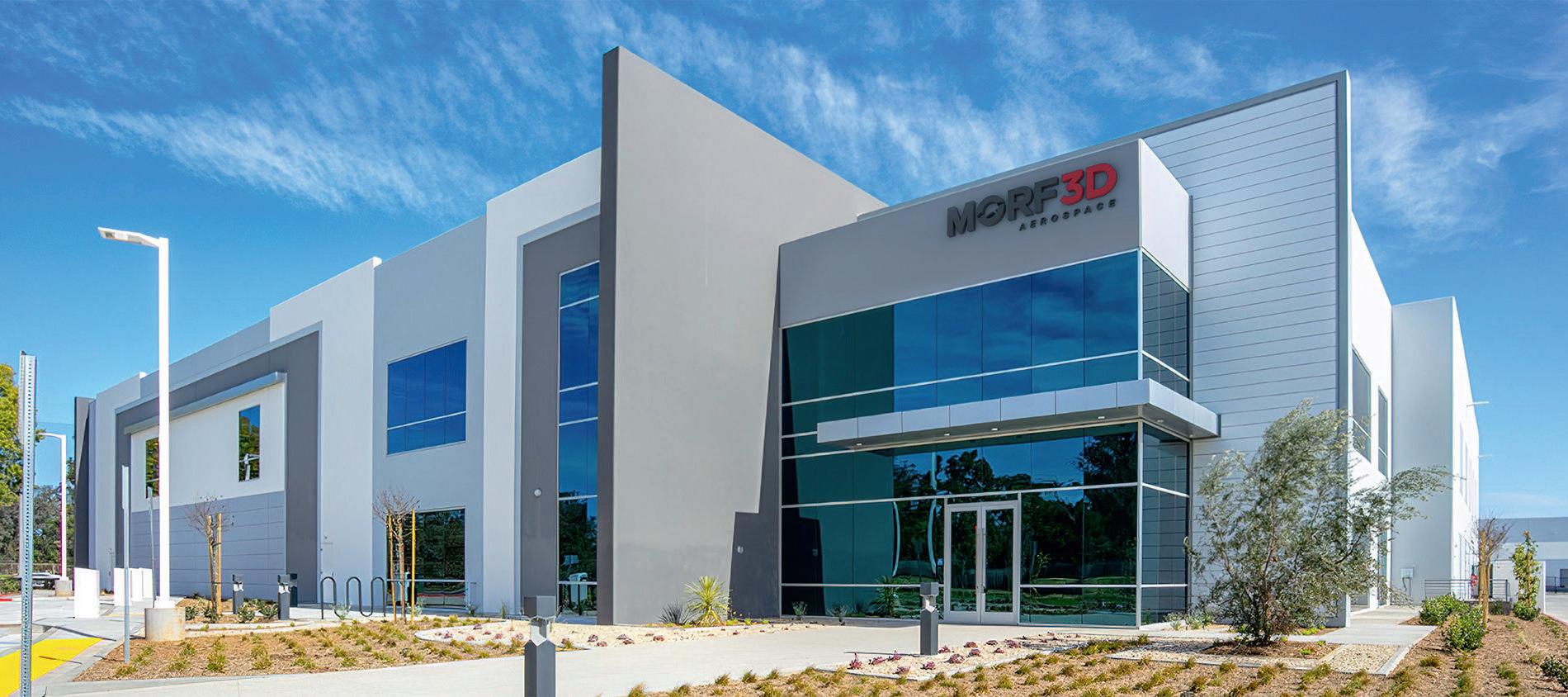
6 minute read
AM GOES DOWN A STORM
Sam Davies speaks to BAE Systems Head of Additive Manufacturing Jenny Manning [JM] on leading AM activity at the British aerospace leader.
Jenny Manning joined BAE Systems 15 years ago as an Aerospace Engineering apprentice, where, for three and a half years, she rotated around various engineering and manufacturing placements. In 2011, she qualifi ed as a Manufacturing Engineer and went on to work on the Eurofi ghter Typhoon before moving into a communications role whilst studying for a Manufacturing Systems Engineering degree.
After graduating with a fi rst-class BEng Hons, Manning transitioned back into manufacturing, taking up a role as Senior Manufacturing Engineer where she led technology insertion for additive manufacturing (AM) processes. In the years since, she has worked on the Hawk and Tempest aircraft programs, before being appointed Head of Additive Manufacturing in January 2022. As she settles into that role, TCT caught up with Manning to learn more about how BAE is applying AM technology.
TCT: Can you explain your responsibilities in your new role as Head of Additive Manufacturing?
JM: In my new role as Head of Additive Manufacturing, I am responsible for developing and delivering eff ective additive manufacturing solutions to our customer base. From an agile R&D capability to establishing a robust production environment, so that additive manufacturing becomes a key solution for future platforms. I am accountable in defi ning our future vision for additive manufacturing and how we continue to work closely with academia, suppliers, partners and industry in developing the technology further to provide value and benefi t. JM: I was aware of 3D printing from the early days of my career as an apprentice, as I had seen fi rst-hand some of the tooling and shop aids on the shop fl oor. However, I wasn’t formally introduced to it until 2015. By that time, the company had been using additive manufacturing for nearly 15 years, but predominately polymer processes such as SLA and FDM, making prototypes and visualization models and some one-off tooling applications.
TCT: Can you tell me about how BAE Systems’ application of 3D printing compares today? What application examples show the benefi ts of AM in aerospace/ defence?
TCT: At what stage in your career were you introduced to 3D printing and, at that stage, how was BAE using the technology?
JM: Today we run various materials on Stereolithography (SLA), Fused Deposition Modelling (FDM), Selective Laser Sintering (SLS) and Selective Laser Melting (SLM). Manufacturing everything from prototypes, mock-ups, visualization models, tooling and product components on varied platforms.
We have seen signifi cant cost and lead time savings in some of our tooling and aircraft ground equipment applications. As well as some components we have on Hawk and Typhoon – by using AM, parts were re-designed, and although still classed as a substitutional part, the AM process saved 40% in cost and 60% in lead time when compared to the conventional manufacturing methods.
Additive manufacturing, however, really adds value when you design for the process at the start. On Typhoon, the ECS cooling ducts, due to a radar requirement, required improved air fl ow.
SHOWN:
MANNING WITH A 3D PRINTED COOLING DUCT
By using AM, we were able to redesign a component, that conventionally was made out of 14 items, and manufacture one singular piece with integrated cooling channels which provided a signifi cant performance improvement. On top of this, we can nest four of them within the build chamber increasing build effi ciency.
TCT: And what do you see as the big opportunities for additive in this industry and within BAE Systems moving forward?
JM: As part of our future manufacturing vision, you can see our approach fi rsthand through our ‘Factory of the Future’ in Lancashire, UK where we have projects that demonstrate the very leading edge of additive manufacturing. This is opening the door to new possibilities, including the manufacture of large-scale additive parts for military aircraft. Those developments are made possible through collaboration, in this case working with a diverse range of suppliers and academia including Siemens, Renishaw and The University of Sheffi eld’s Advanced Manufacturing Research Centre.
TCT: You’ve previously held the role as the IPT leader for the Tempest aircraft program and in July 2020 it was announced BAE was targeting using AM to produce 30% of the Tempest componentry – an increase from 1% on the Typhoon aircraft. How is this project progressing?
JM: The testing of ever bigger and more complex shapes to see which parts of the aircraft can be made through additive manufacturing is a huge steppingstone on that journey. We are close to completing a demonstration model of the aircraft’s front fuselage using new robotic technology and increased levels of automation and additive manufacturing. We are challenging our engineers to make sure this latest application of technology can be exploited in the current Typhoon aircraft, as we recognize the benefi ts it can bring in cutting production time and reducing material and energy consumption. In recent trials, we reduced the production time of a large engine mount frame for a Typhoon aircraft, from 100 weeks to just 60 days. The Typhoon of today is completely diff erent under the skin to the jet that entered operational service in 2003 and is designed to develop and deploy 21st century technologies, future-proofi ng Typhoon for decades to come and proving technologies, which will become central to a future combat air system.
TCT: How would you assess the suitability of 3D printing for BAE Systems’ requirements?
JM: Additive manufacturing lends itself to many applications. However, to ensure that you are getting the most out of the technology, you must ensure you are designing for the process at the start. Understanding the design principles to apply will result in a better product, as well as ensuring that you are getting value out of the technology. It’s also really important to know that additive manufacturing is just another tool in the toolbox, and is a complementary process to all our other conventional manufacturing methods; additive manufacturing doesn’t replace any of them, it just gives us wider capability.
TCT: What would you outline as the key challenges facing BAE Systems and others in growing their application of AM?
JM: We recognize the critical role our programs of today and tomorrow play in creating high value, highly skilled jobs, however we are fully aware of the skills shortages across the manufacturing and engineering sectors. As a company, we are absolutely committed to work closely with third parties and local education partnerships to create the next generation of talent and skills. One way we are developing this talent is through our apprentice and graduate programs, where we are recruiting almost 1,700 apprentices and graduates across the UK this year. In collaboration with CREATE Education, we’re also nurturing new digital skills in Lancashire to address skills shortages and support a levelled-up recovery from the pandemic. Investing in these skills will create a pipeline of highly skilled experts that are crucial to our future as a leading manufacturing nation, helping to sustain the North West of England’s position as the UK’s home of aerospace manufacturing.
TCT: Finally, how would you assess the impact 3D printing technology is having within BAE Systems?
JM: Over the last fi ve to seven years, we have seen a real increase in exploitation of additive manufacturing across all our Air programs and wider business units; including Submarines, Maritime and Land application. Our knowledge and understanding across the company are growing day by day and we are really starting to see the benefi t of utilizing the technology on our products. We are also seeing a whole new technological skillset be developed, which is exciting for future skills and talent within the company. It’s exciting to be part of the next generation of manufacturing and playing a key role in moving towards Industry 4.0.











